ATI Radeon 5770 & 5750 Review
ATI divides its products into segments based on price, power requirements and performance. The complete breakdown is as follows:
- Ultra Enthusiast: 5970, Eyefinity 6 and CrossFireX
- Enthusiast: 5870, 5850, 5830
- Performance: 5770, 5750
- Mainstream: 5670, 5550, 5450
To date we have benchmarked and reviewed the products in the Ultra Enthusiast and Enthusiast segments. This review will cover the Performance segment. In my review of the Enthusiast segment, I found that both the 5850 and the 5830 were more than adequate for widescreen users and provided a solid Eyefinity experience (assuming you went in with appropriate expectations).
As we take a step down further into the Performance segment, we will determine if the 5700 series is truly a "performer" for widescreen and Eyefinity users. As before, we will bookend the benchmark data with the low end of the Enthusiast market, and the high end of the Mainstream market.
Architecture & Specs
The main differentiator within the Ultra Enthusiast segment is clock speed (per GPU). The 5870, Eyefinity6 and 5970 all carry the same number of shaders (per GPU). The Enthusiast segment has variances in clock speed, but also begins reducing the number of Unified Shaders on the GPU.
Below is a spec block with comparing outlining the 5830 through the 5670:
| Card | GPUs | Transistors | Max Memory | Shaders | Clock (MHz) | TDP (Watts) | MSRP* | ||
| Core | Mem | Idle | Max | ||||||
| ATI Radeon HD 5830 | 1 | 2.15B | 1GB | 1120 | 800 | 1000 | 25 | 175 | $249 |
| ATI Radeon HD 5770 | 1 | 1.04B | 1GB | 800 | 850 | 1200 | 18 | 108 | $174 |
| ATI Radeon HD 5750 | 1 | 1.04B | 1GB | 720 | 700 | 1150 | 16 | 86 | $134 |
| ATI Radeon HD 5670 | 1 | 627M | 1GB | 400 | 775 | 1000 | 14 | 61 | $109 |
| As these cards have been on the market some time, price is based on current average | |||||||||
Based on the stat block you can see the variation within the 5700 family. The number of shaders steadily decrease, however there is a "saw tooth" stepping of the memory and clock speeds. The 5770 carries higher clocks than the 5830. On the other hand, the core clock speed of the 5750 is lower than both of the 5830 and the 5770, and the memory clock falls between the two.
Notes
The ATI Radeon HD 5670 I tested was only equipped with 512MB of RAM. ATI sent this card out to reviewers so that they could show performance on a sub-$100 card. All other cards in this review contained 1GB of RAM.
ATI Radeon 5770 & 5750 Review - Benchmarking
Setup & Installation
The HD 5770 and HD 5750 contain the same connections as the original HD 5870 - 1x HDMI, 1x DisplayPort and 2x DVI. As with the HD 5870, each card was connected with a DP-DVI-DVI configuration.
Configuration of the Eyefinity group within the Catalyst Control Center works as previously outlined. Bezel Compensation continues to work in the same manner. Both of these features are software based, and not dependent on the individual card.
System Specs
For all 16:10 benchmarks I used my existing three Dell U2410 monitors. For the 16:9 benchmarks, I used Dell P2210H monitors provided by ATI. The 10.3 preview driver was used on all cards.
My testing rig remains unchanged (except for driver updates and monitor configurations). It currently stands at:
- Windows 7
- EVGA X58 Tri-SLI Motherboard
- Intel i7 920 at 4x2.67GHz
- 12GB G.Skill DDR3 RAM
- 2x Samsung 320GB T-Series HDD (one for the OS and games; one for swap file and FRAPS)
- LG Super Multi Blu (HD-DVD/Blu-Ray Player)
- Onboard audio
- Corsair HX1000
- Antec Skeleton
- Logitch K340 Keyboard & Performance MX Mouse
- Ergotech Heavy Duty Triple Desk Stand
Note: The ATI Radeon HD 5670 I tested was only equipped with 512MB of RAM. ATI sent this card out to reviewers so that they could show performance on a sub-$100 card. All other cards came with 1GB of RAM.
Resolutions Tested
I initially tested at 1920x1200 and 1680x1050, along with the respective 3x1-L iterations of 5760x1200 and 5040x1050. These are the most common resolutions for single screen and Eyefinity.
Setups based on 1920x1080 or 1600x900 panels are becoming popular as well. In my review of the HD 5870 Eyefinity6, I looked at any performance difference between 16:10 and 16:9 screens. The differences were minimal, if any.
Games Tested
I wanted to choose games that covered a variety of genres (action, FRP, RTS and racing), and a variety of technologies (DX9, 10 and 11). Some games are older and well known titles such as Half-Life 2 and Far Cry 2. Half-Life 2 chews through video cards at lower resolutions and even 3x1-L, but how does it scale to five and six monitors? Far Cry 2 is still tough on systems (at Ultra settings). Will it even be playable at these new configurations. I also wanted to test games that were new and demanding, so that we can begin "aging" them over time. I chose titles such as Battle Forge and the new S.T.A.L.K.E.R. demo for these reasons.
I chose games that had a built-in benchmark tool. This allows for repeatability and a relative "hands off" testing. Finally, all games must exhibit Hor+ behavior in widescreen and Eyefinity. The games I ended up testing were:
- Batman: Arkham Asylum
- Battle Forge
- DiRT 2
- Far Cry 2 (including full comparison of 1GB vs. 2GB)
- Grand Theft Auto IV
- H.A.W.X.
- Heaven Benchmark v1
- Half-Life 2: Episode 2 & Lost Coast
- S.T.A.L.K.E.R.: Call of Pripyat Benchmark Tool
Hitting 60
In each game, I attempted to find settings that would allow me to hit 60fps at 1920x1200 (single widescreen) and 5760x1200 (3x1 Eyefinity) with the HD 5770. In some instances this was simply not achievable (as was the case in some games on the HD 5870 and Eyefinity6 cards), and I tried to find settings that would reach 30fps.
ATI Radeon 5770 & 5750 Review - Batman: Arkham Asylum
Batman: Arkham Asylum is the well received action title by Rocksteady. The game offers very detailed environments with a great visual style and high quality. There are known issues with AA using ATI cards. You cannot set the AA level from within the game, and have to force it with the Catalyst Control panel. All settings within the game were maxed out. I used 4xAA with Adaptive Multi-Sampling (the balance between Quality and Performance) from within the CCC.
The AA implementation produces a greater than expected impact on the performance. I know there are ways to tweak the game to use the AA from within the game itself. However, I believe finding the information and implementing it is beyond the average gamer. While an enthusiast (i.e., target market of both the WSGF and this card) might go through the trouble, many mainstream gamers will not. My testing actually ran all the way down through the Radeon HD 5450, and using the "native" options provided the most consistent platform for testing.
The games runs like a demon in normal widescreen on any of these cards, with 4xAA. The HD 5770 almost cracks 60fps at 1920x1200. However, performance takes the expected hits in Eyefinity, and this is what we are really here to test. At the native resolutions of 5760x1200 (3x1920x1200), the game literally crawls with 4xAA on any card. You will have to make some adjustments for playable frame rates, and dropping to 2xAA gives massive speed improvements.
Batman:AA (pun actually not intended) is a unique title. It is made well, and plays well, but technical issues can really hamper performance. The impacts are so great that 5760x1200 is simply unplayable with any card.
The 5770 and 5750 offer a fairly linear scaling from the 5830. There are significant performance reductions when moving to the HD 5670.
Hitting 60fps
Widescreen - 2xAA and Very High settings gives you 60fps at 1920x1080
Eyefinity - 0xAA/High gives you 49fps at 5760x1200. Dropping the resolution to 4800x900 yields bigger improvements. 0xAA/Very High gives you 54fps, while 0xAA/High gives you 69fps.
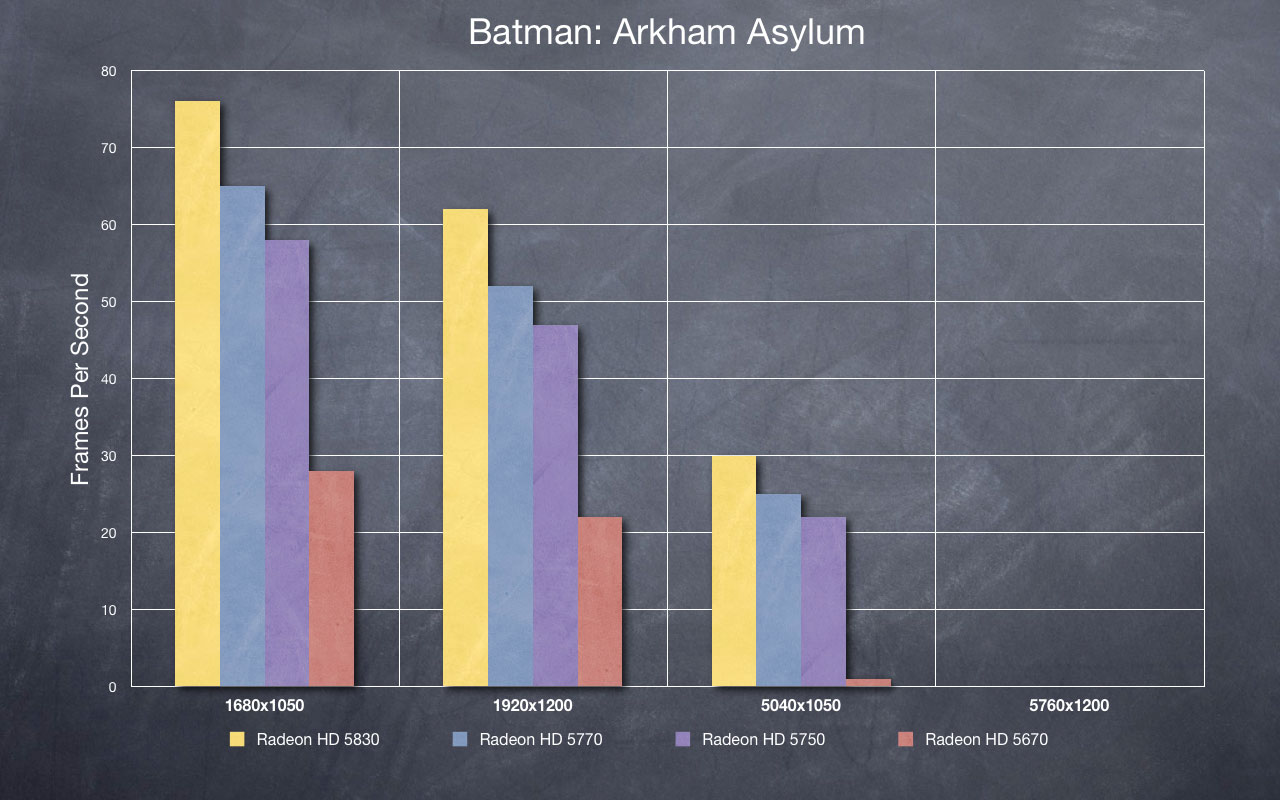
ATI Radeon 5770 & 5750 Review - Battle Forge
Battle Forge is the free-to-play RTS from Electronic Arts. It offers a steampunk/fantasy RTS experience, where armies are build based on "decks" of cards similar to the Magic: The Gathering card game.
Battle Forge is one of ATI's spotlight (my terminology) games for the HD 5000 series cards, as it offers both DX11 and proper Eyefinity support. The game offers a number of DX11 features, and a wealth of options for tuning performance. Specifically, Battle Forge uses DX11 and Shader Model 5.0 to compute HighDefinition Ambient Occlusion (HDAO). For our tests we maxed out all of the settings and forced DX11 through the config.xml file.
The test is actually quite strenuous with the number of objects, effects and particles on the screen at one time. There is a noticeable performance increase as you scale across the cards, and then trend actually continues all the way across a pair of Eyefinity6 cards in CrossFireX.
Again the 5770 and 5750 both offer fairly linear scaling, especially in widescreen. 30fps isn't attainable in either widescreen or Eyefinity with all settings maxed. Playable framerates can be achieved with reduced settings.
Hitting 60fps
Widescreen - 50fps by reducing resolution to 1600x900, 0xAA, turned off DX11 and SSAO and set everything to Medium quality.
Eyefinity - 29fps by reducing the resolution to 4800x900 (3x1600x900) and using the above settings.
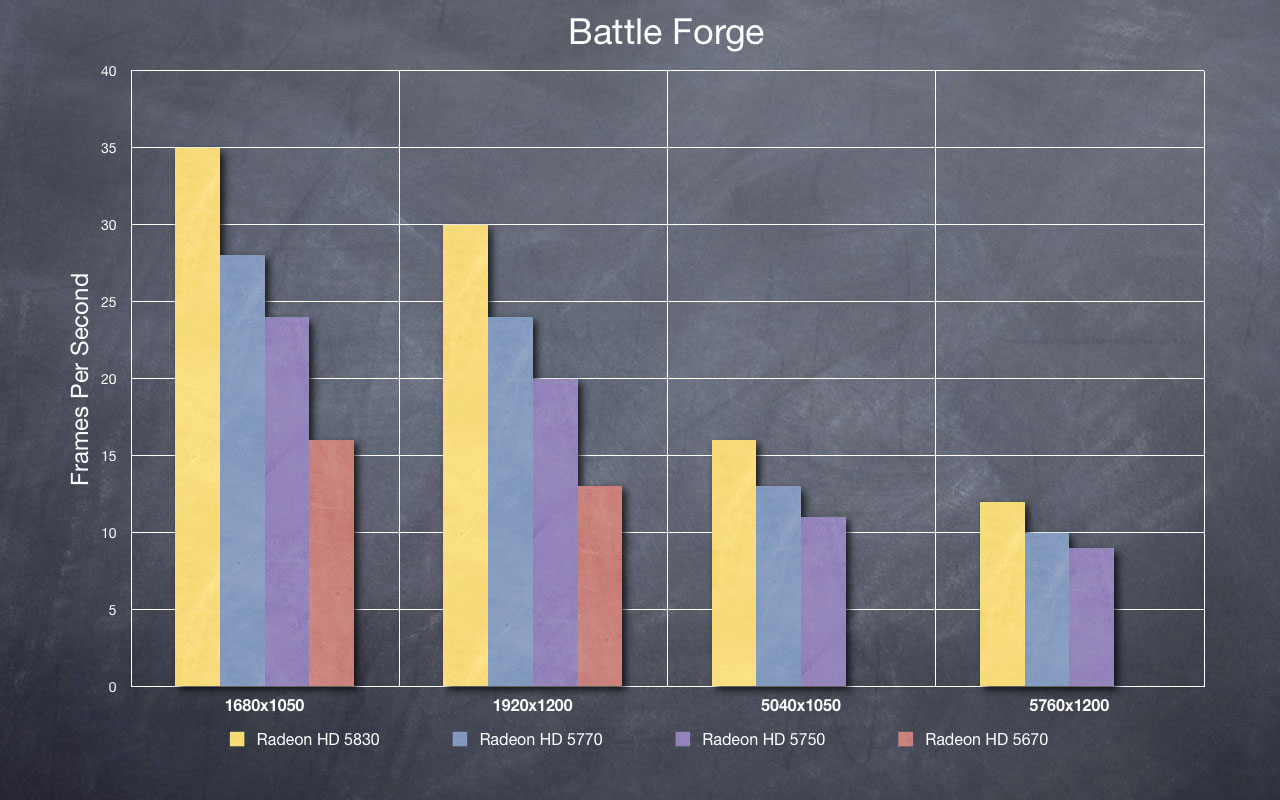
ATI Radeon 5770 & 5750 Review - DiRT 2
Dirt 2 is the latest iteration of the Dirt rally racing series from Codemasters. Like Battle Forge, Dirt 2 is a spotlight game for ATI with the HD 5000 series. Like Battle Forge it offers proper Hor+ gameplay in Eyefinity and DX11 support. Unless the user goes into the "hardware_settings_config.xml" file and forces DX9, Dirt 2 runs in DX11 mode. Unfortunately Dirt 2 does not offer a DX10 mode. This is unfortunate, as many games show improved performance when running in DX10 vs. DX9.
The true (noticeable) DX11 features come in to play based on the user settings in the in-game graphics options. Several key features are the "Hardware Tessellated Dynamic Water" (achieved through "Ultra" quality water), "Hardware Tessellated Dynamic Cloth" (achieved through "High" quality cloth), and DX11 Accelerated HDAO (through "High" quality HDAO).
The DX11 water and cloth offer more realistic geometry and movement. The DX11 water produces actual waves in deep puddles (as the player drives through), rather than simple "swirls" in the texture surface. The DX11 cloth offers more realistic ripples and waves in the cloth material over the DX9 version. On the other hand, the DX11 HD Ambient Occlusion (HDAO) offers an accelerated computation path.
DX11 doesn't necessarily provide earth-shaking changes to gameplay. But, it provides more realistic "movement" in the world's objects - cloth, water, grass, etc. While a DX9 or DX10 game is perfectly enjoyable, the DX11 technology offers better immersion by making the "little things" more lifelike. Additionally, it offers better computation paths through increased parallelism (and better computation paths for DX10), much like DX10 offered better performance (over DX9) in games such as Far Cry 2.
Both cards perfom quite well in widescreen at max settings, and perform north of 30fps in widescreen. Eyefinity brings some pretty heavy performance hits. The performance of the 5670 is significantly lower than the 5700 series.
Hitting 60fps
Widescreen - I was able to hit 57fps by moving all settings from Ultra to High, setting 2xAA and setting Post Processing to Medium. I hit 61fps by setting 0xAA.
Eyefinity - I was able to hit 54fps by dropping settings to 4800x900 at 0xAA. All other options were set to Medium, with the exception of: Post Processing, Ambient Occlusion, Particles, Crowd, Ground Cover and Cloth. All of those were set to Low.
With plenty of options, there are a number of variations available to suit your taste.
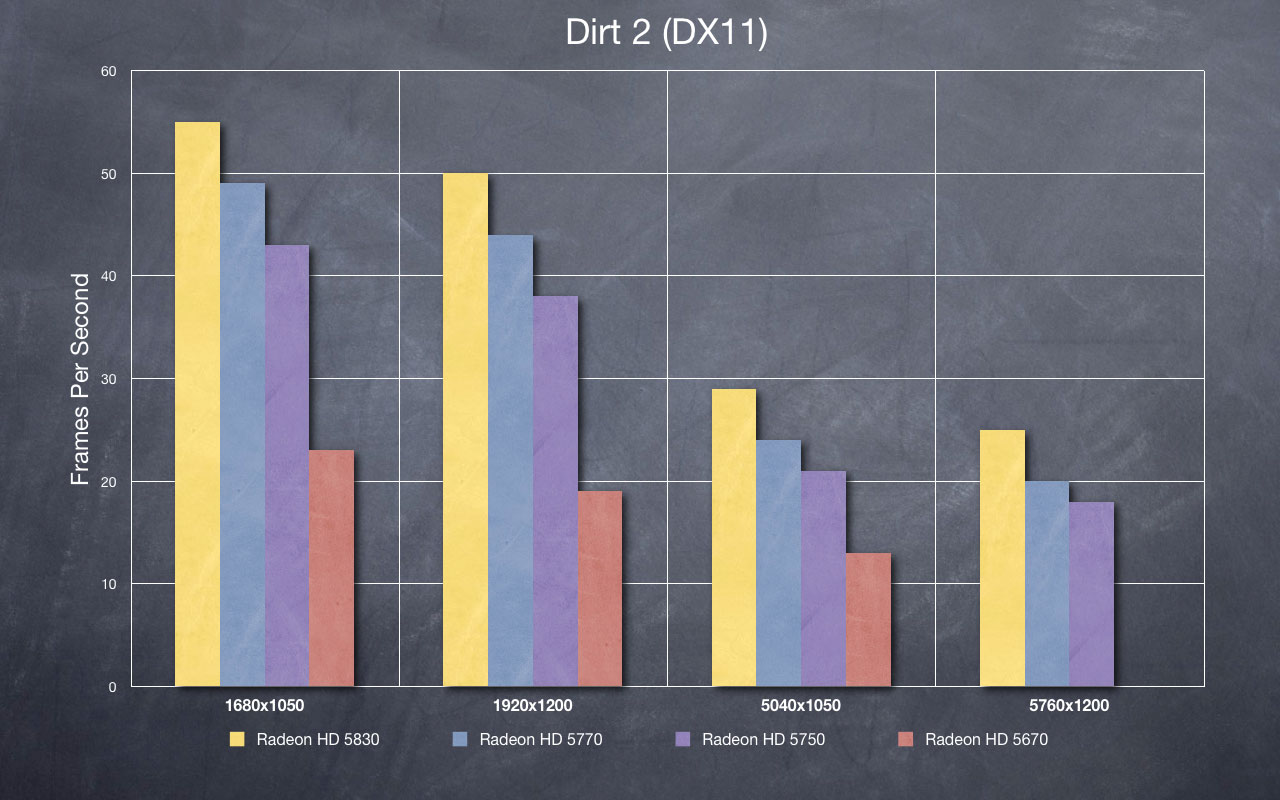
ATI Radeon 5770 & 5750 Review - Far Cry 2
Far Cry 2 (and the whole Cry/Crysis series) has long been considered a system killer. If not a killer, then at least a good strong test. As always, we run our test at max settings with 4xAA. The benchmark tool within Far Cry 2 offers settings for High, Very High and Ultra. We chose Ultra with 4xAA.
While once a true system killer, Far Cry 2 shows that hardware catches up to software. Even a sub-$200 card provides an easily playable experience.
There is a larger gap in performance between the 5750 and the 5670. With the proper tweaks, Far Cry 2 would be playable on a 5770 in Eyefinity. The "mainstream" moniker of the 5670 begins to stand out as mainstream users are single display users.
Hitting 60fps
Widescreen - 60fps can be hit by dropping the settings to 0xAA and Very High.
Eyefinity - 60fps can be in with the above settings, and 4800x900.

ATI Radeon 5770 & 5750 Review - Grand Theft Auto IV
I initially chose GTA IV based on the fact that it had a built-in benchmark tool, and based on the fact that it was considered a system killer at max settings. Realistically, I don't believe the GTA IV benchmark tool offers a good representation of the actual gameplay experience. The benchmark is very much a "corridor" run on a dense city street, while the game itself is open world and many locations offer variety architecture and/or a distant horizon. Additionally, the benchmark is set during a nighttime setting. While this is potentially good for showing off the game's neon lighting effects, it offers no sun, clouds, atmospheric coloring, lens flare or texture variety in the sky.
Additionally, I found that the game hit a CPU limit of 45/46fps at 1680x1050 on a Radeon HD 5830 - not exactly cutting edge hardware. The one benefit of the game is that the graphics option screen offers a reading of your system VRAM and calculates how much is needed based on your selections. By default it won't let you go over the limit of your video card.
With a couple of command line switches, the game allows you to max everything out well and beyond what your system is "capable of." Down side it that overloading the video card seems to have little effect. I'm not certain if the non-existent limit is due to the horsepower of the Radeon 5000 series, or limitations of the benchmark tool.
The only time I found the limit to be an actual impediment is when I tried to max out the settings on a the Radeon 56/44/54xx series with 512MB of RAM. At that low of a framebuffer, the benchmark wouldn't load. Otherwise, I could overload the 1GB VRAM all I wanted, and the game performed reasonably well.
Hitting 60fps
Considering the problems I had trying to improve performance on my Eyefinity6 review, I didn't bother going through the effort here. Below is what I reported from that review:
"I worked for a while to get an fps improvement on this benchmark tool. Even cutting the settings to 1/2 or 1/3 of max, and I had only increased 2fps to 30fps total. I'm sure that lower settings would make an impact in the real game, but I'm not seeing it here. I'm also do for a re-format and re-install. Don't think I will be carrying over GTA IV into the benchmark lineup, given its limited impact."
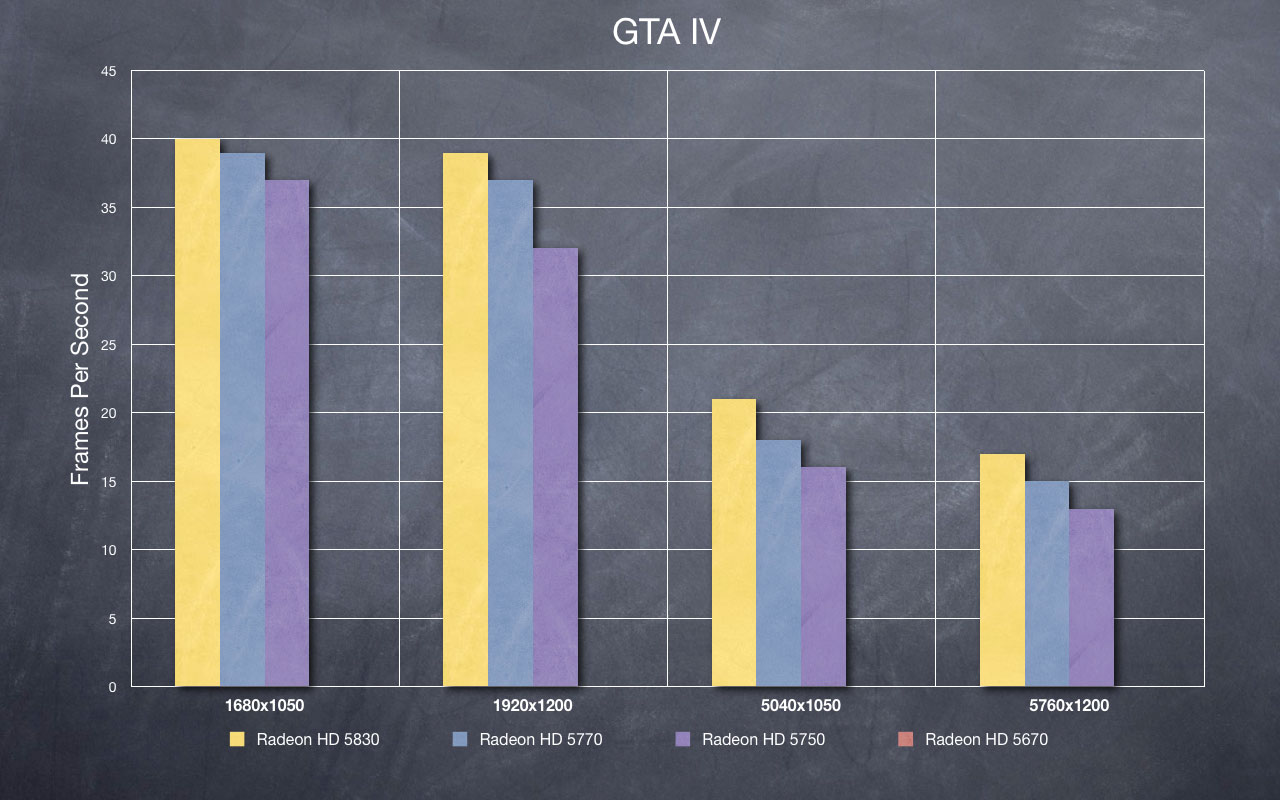
ATI Radeon 5770 & 5750 Review - H.A.W.X.
H.A.W.X. is one last title that ATI has been showing off with regards to its Radeon 5000 line. While the other titles are Hor+ and offer cutting-edge DX11 features, HAWX is quite the opposite. While it is a Hor+ title, it is only a DX10 title and runs quite well on a wide variety of hardware. While you can't hit 60fps on a 5700 or 5600 card with any great detail, 30fps is rather easily attainable.
The well running and scalable title makes it a natural fit when showcasing both lower-end hardware pushing three panels, and high-end hardware pushing six panels. It also comes as no surprise that the additional VRAM largely goes unused, considering the title runs capably on lower hardware.
One note in the HAWX benchmark. Above 1920x1200 the game simply would not allow 4xAA. While the scores provide that the title could handle it, the option simply is not available. Though it isn't our norm, we chose to accept 2xAA so that we could get consistent readings across the spectrum of hardware.
HAWX produces a clean stair step performance curve all the way through the 5750, in both widescreen and Eyefinity. The 5770 breaks 60fps at 1680x1050, and 30fps at 5040x1050 - all at max settings (except for the 2xAA). There is a significant performance drop with the 5670. With the right tweaks even the 5670 is playable at high fps on lower resolutions.
Hitting 60fps
Widescreen - I hit 65fps by turning the DX10 settings down one notch each. Shadows and Sun Shafts were set to Low, and SSAO to Medium.
Eyefinity - In addition to the above settings, dropping SSAO to low produced 46fps. Dropping the resolution to 4800x900 hit 61fps.
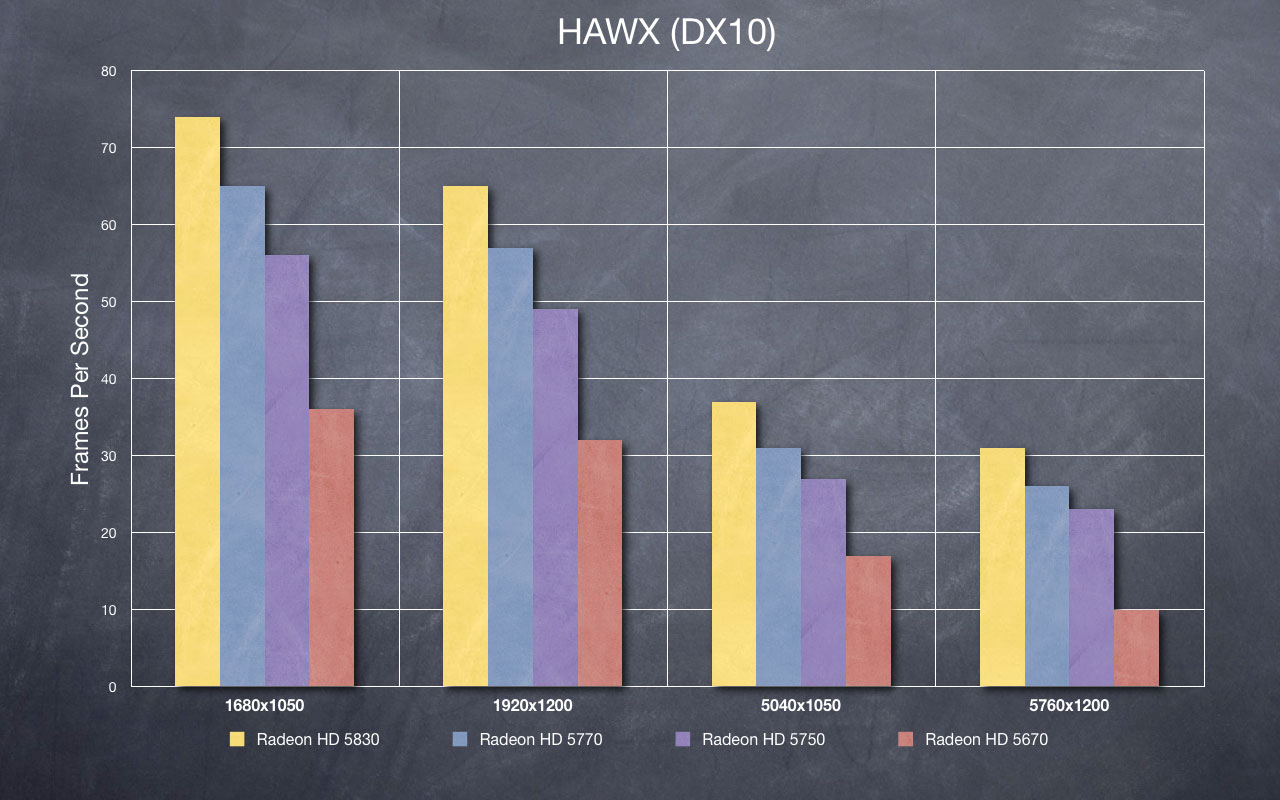
ATI Radeon 5770 & 5750 Review - Half-Life 2
Half-Life 2 is the classic first person shooter. It is a DX9 title. At this point DX9 doesn't really tax graphics hardware with any of its "features," and any benchmarking comes down to a pushing raw pixels. Half-Life 2 does not like the extra video RAM provided by 2GB cards, and does not like the Eyefinity6 in CFX.
The Source Engine is no match for the 5700 series. Widescreen resolutions produce results in excess of 120fps on the 5770, and 90fps+ with the 5750. Both cards post 30fps+ at 5760x1200, at max settings for Episode 2.
Given the DX9 nature of the title, the Episode 2 iteration of the Source engine is not shader-dependant. At widescreen the engine responds better to raw clock speed, and the 5770 actually performs better than the 5830. If you are a fan of games based on the Source engine (HL2, Team Fortress 2, and the Left4Dead series), the 5700-series (and the 5770 in particular) provides an exceptional return on your investment.
Hitting 60fps
Widescreen - Both cards double the 60fps goal in widescreen.
Eyefinity - Both cards break the 60fps ceiling on Lost Coast, and average 45fps on Episode 2.
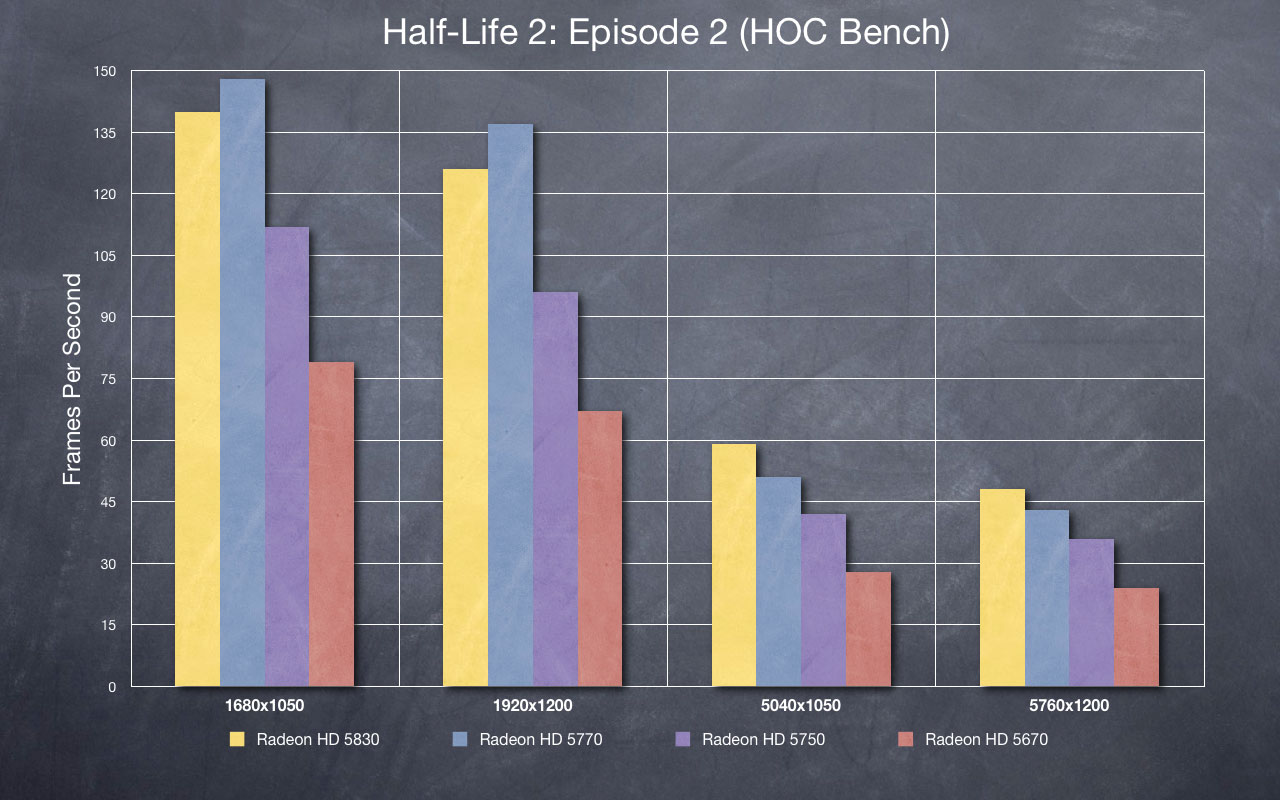
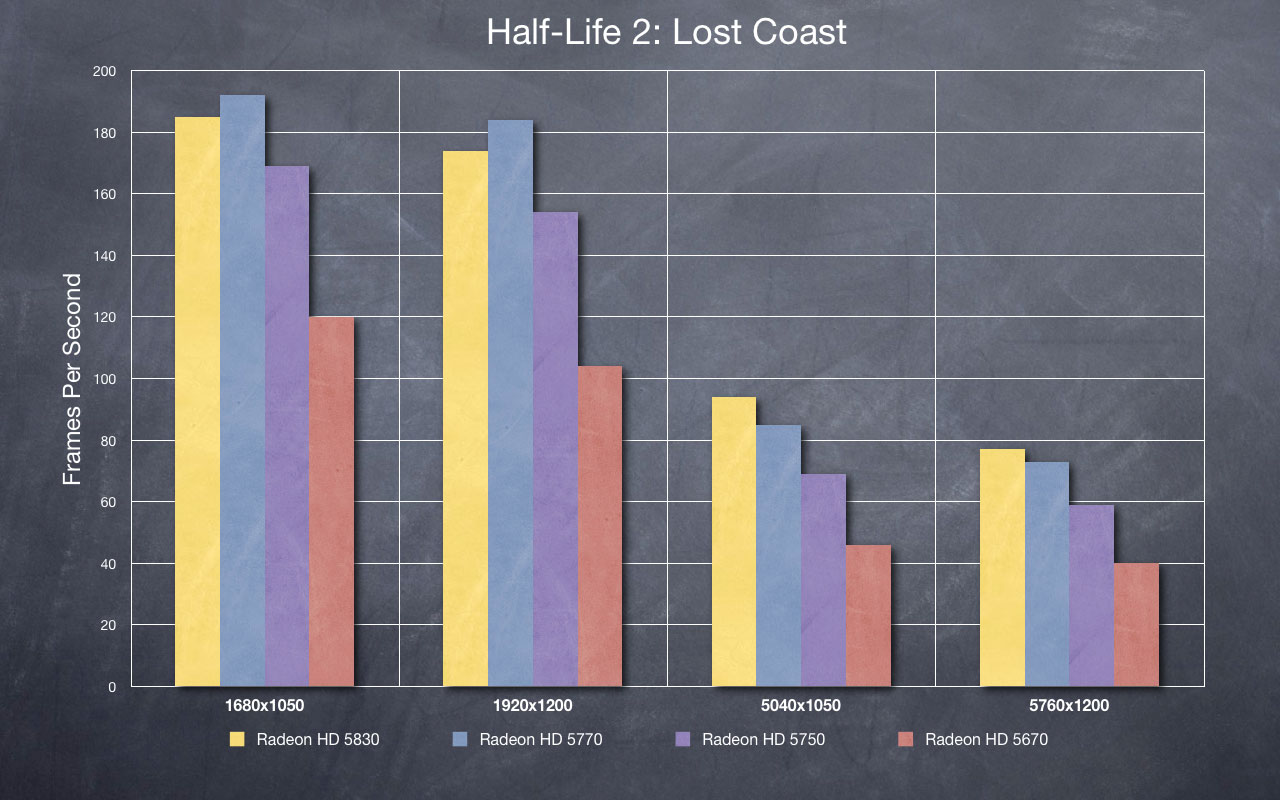
ATI Radeon 5770 & 5750 Review - Heaven Demo
The Unigine Heaven Demo is unique in that it is the only demo which allows for the following components in one package.
- Synthetic Demo (i.e., a demo designed to "test" a system)
- Comparable tests of DX9, DX10 and DX11
- Is Hor+ (rather than limited to a few predefined aspect ratios)
The ability to compare DX9, DX10 and DX11 in the same environment allows for the unique ability to see how the different cards perform across these different comparable environments.
Both cards offer linear performance in widescreen across DX9, DX10 and DX11. The 5770 hits 30fps in DX9 at 1680x1050, and performance falls as expected in DX10 and DX11 (considering the strenuous nature of the test).
The 5700 cards can run the DX9 benchmark in Eyefinity, but it's barely more than a slideshow. The 5670 runs at just 1fps. None of the cards can run the test in Eyefinity at DX10 or DX11. These tests are strenuous on any card being sold today.
Hitting 60fps
It is not possible to hit 60fps with this benchmark on a single GPU at Eyefinity resolutions. Considering it is meant to test/tax your system, that is to be expected. Here is what I was able to achieve:
Widescreen
- DX9: 1600x900, 0xAA, 1xAF, low shaders - 46
- DX10: 1600x900, 0xAA, 1xAF, low shaders - 44
- DX11: 1600x900, 0xAA, 1xAF, tessellation enabled, low shaders - 30fps
Eyefinity
- DX9: 4800x900, 0xAA, 1xAF, low shaders - 22
- DX10: 4800x900, 0xAA, 1xAF, low shaders - 22
- DX11: 4800x900, 0xAA, 1xAF, tessellation enabled, low shaders - 17fps
ATI Radeon 5770 & 5750 Review - Heaven Demo DX9
The Unigine Heaven Demo is unique in that it is the only demo which allows for the following components in one package.
- Synthetic Demo (i.e., a demo designed to "test" a system)
- Comparable tests of DX9, DX10 and DX11
- Is Hor+ (rather than limited to a few predefined aspect ratios)
The ability to compare DX9, DX10 and DX11 in the same environment allows for the unique ability to see how the different cards perform across these different comparable environments.
Both cards offer linear performance in widescreen across DX9, DX10 and DX11. The 5770 hits 30fps in DX9 at 1680x1050, and performance falls as expected in DX10 and DX11 (considering the strenuous nature of the test).
The 5700 cards can run the DX9 benchmark in Eyefinity, but it's barely more than a slideshow. The 5670 runs at just 1fps. None of the cards can run the test in Eyefinity at DX10 or DX11. These tests are strenuous on any card being sold today.
Hitting 60fps
It is not possible to hit 60fps with this benchmark on a single GPU at Eyefinity resolutions. Considering it is meant to test/tax your system, that is to be expected. Here is what I was able to achieve:
Widescreen
- DX9: 1600x900, 0xAA, 1xAF, low shaders - 46
- DX10: 1600x900, 0xAA, 1xAF, low shaders - 44
- DX11: 1600x900, 0xAA, 1xAF, tessellation enabled, low shaders - 30fps
Eyefinity
- DX9: 4800x900, 0xAA, 1xAF, low shaders - 22
- DX10: 4800x900, 0xAA, 1xAF, low shaders - 22
- DX11: 4800x900, 0xAA, 1xAF, tessellation enabled, low shaders - 17fps

ATI Radeon 5770 & 5750 Review - Heaven Demo DX10
The Unigine Heaven Demo is unique in that it is the only demo which allows for the following components in one package.
- Synthetic Demo (i.e., a demo designed to "test" a system)
- Comparable tests of DX9, DX10 and DX11
- Is Hor+ (rather than limited to a few predefined aspect ratios)
The ability to compare DX9, DX10 and DX11 in the same environment allows for the unique ability to see how the different cards perform across these different comparable environments.
Both cards offer linear performance in widescreen across DX9, DX10 and DX11. The 5770 hits 30fps in DX9 at 1680x1050, and performance falls as expected in DX10 and DX11 (considering the strenuous nature of the test).
The 5700 cards can run the DX9 benchmark in Eyefinity, but it's barely more than a slideshow. The 5670 runs at just 1fps. None of the cards can run the test in Eyefinity at DX10 or DX11. These tests are strenuous on any card being sold today.
Hitting 60fps
It is not possible to hit 60fps with this benchmark on a single GPU at Eyefinity resolutions. Considering it is meant to test/tax your system, that is to be expected. Here is what I was able to achieve:
Widescreen
- DX9: 1600x900, 0xAA, 1xAF, low shaders - 46
- DX10: 1600x900, 0xAA, 1xAF, low shaders - 44
- DX11: 1600x900, 0xAA, 1xAF, tessellation enabled, low shaders - 30fps
Eyefinity
- DX9: 4800x900, 0xAA, 1xAF, low shaders - 22
- DX10: 4800x900, 0xAA, 1xAF, low shaders - 22
- DX11: 4800x900, 0xAA, 1xAF, tessellation enabled, low shaders - 17fps
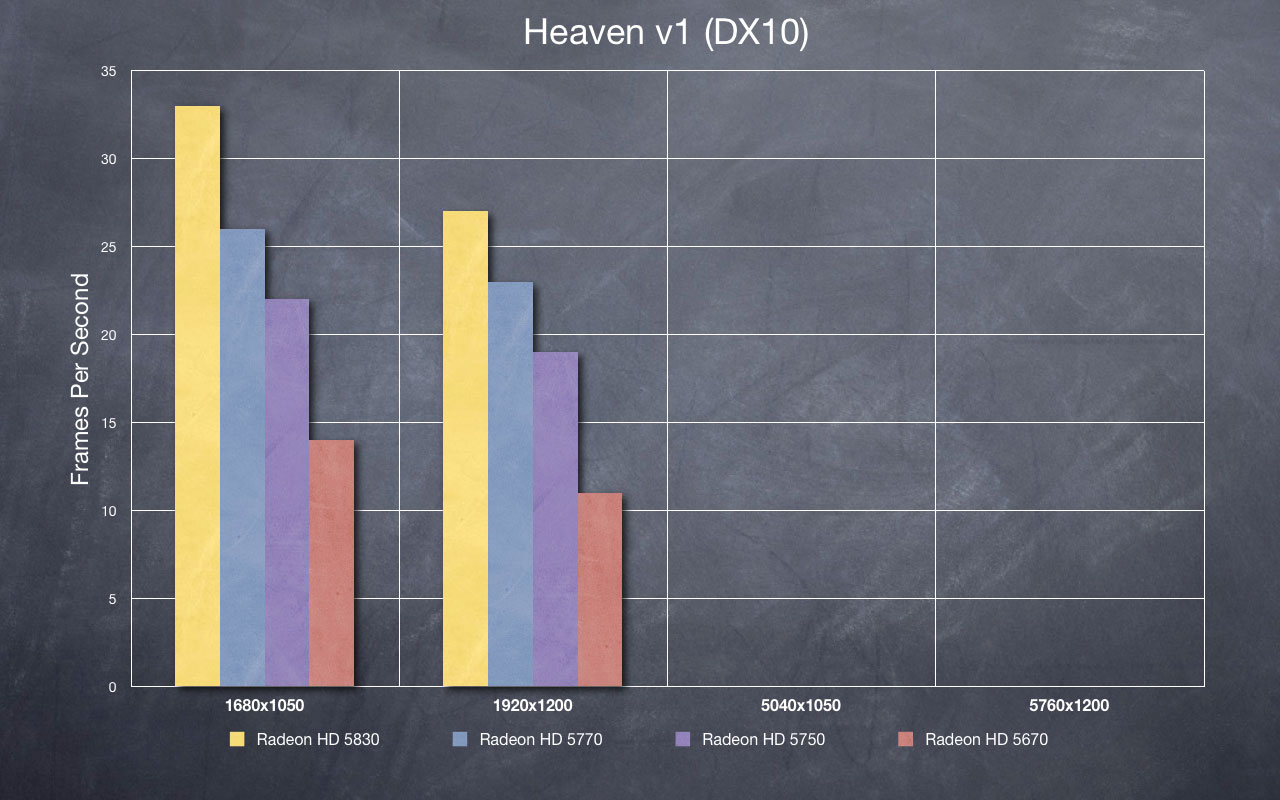
ATI Radeon 5770 & 5750 Review - Heaven Demo DX11
The Unigine Heaven Demo is unique in that it is the only demo which allows for the following components in one package.
- Synthetic Demo (i.e., a demo designed to "test" a system)
- Comparable tests of DX9, DX10 and DX11
- Is Hor+ (rather than limited to a few predefined aspect ratios)
The ability to compare DX9, DX10 and DX11 in the same environment allows for the unique ability to see how the different cards perform across these different comparable environments.
Both cards offer linear performance in widescreen across DX9, DX10 and DX11. The 5770 hits 30fps in DX9 at 1680x1050, and performance falls as expected in DX10 and DX11 (considering the strenuous nature of the test).
The 5700 cards can run the DX9 benchmark in Eyefinity, but it's barely more than a slideshow. The 5670 runs at just 1fps. None of the cards can run the test in Eyefinity at DX10 or DX11. These tests are strenuous on any card being sold today.
Hitting 60fps
It is not possible to hit 60fps with this benchmark on a single GPU at Eyefinity resolutions. Considering it is meant to test/tax your system, that is to be expected. Here is what I was able to achieve:
Widescreen
- DX9: 1600x900, 0xAA, 1xAF, low shaders - 46
- DX10: 1600x900, 0xAA, 1xAF, low shaders - 44
- DX11: 1600x900, 0xAA, 1xAF, tessellation enabled, low shaders - 30fps
Eyefinity
- DX9: 4800x900, 0xAA, 1xAF, low shaders - 22
- DX10: 4800x900, 0xAA, 1xAF, low shaders - 22
- DX11: 4800x900, 0xAA, 1xAF, tessellation enabled, low shaders - 17fps
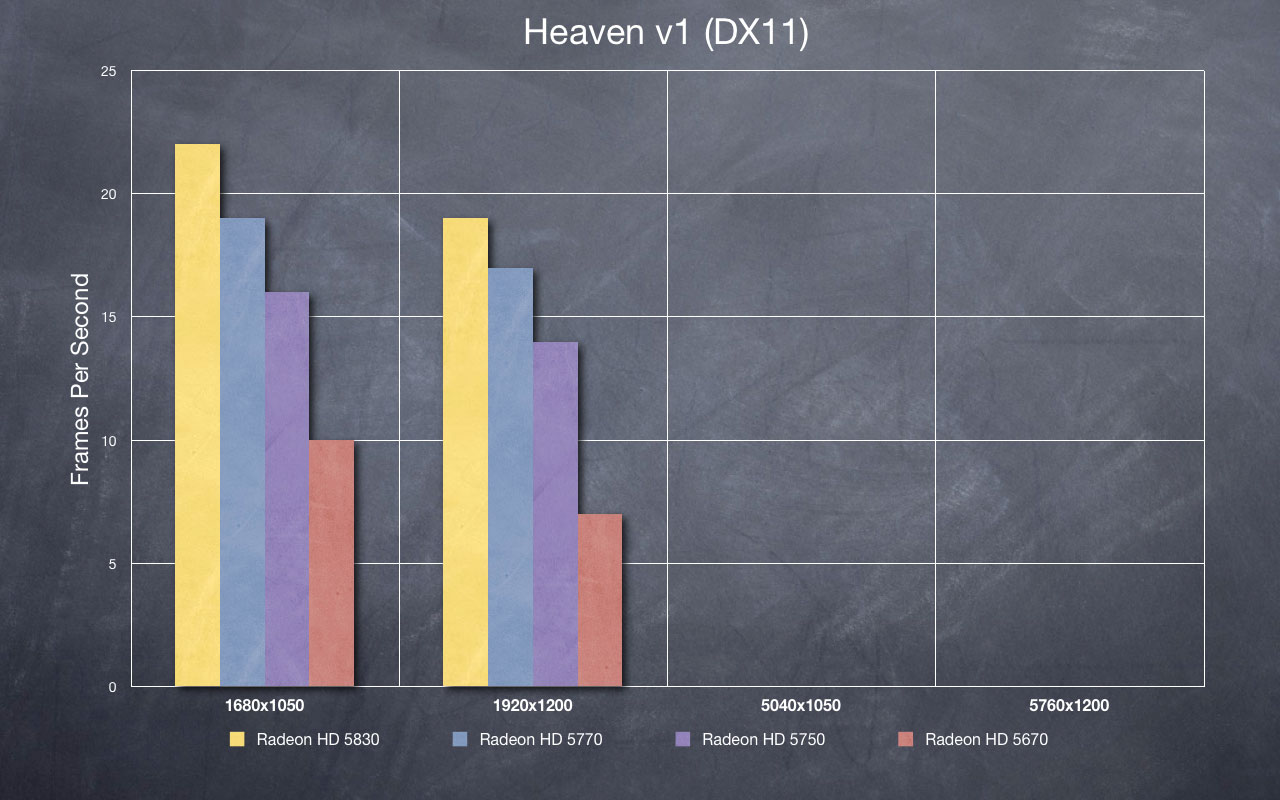
ATI Radeon 5770 & 5750 Review - S.T.A.L.K.E.R.: Call of Pripyat
S.T.A.L.K.E.R. - Call of Pripyat is the new Crysis.
Prior to the game's release, the developer put out a benchmarking tool to test your system configuration. It offers a number of different options for utilizing DX9, 10 or 11 code paths. It also offers options for varying levels of HDAO and Shadow Quality. The demo itself isn't very pretty to look at (lots of dirt and dirt-colors), but it does put a beating on your system.
Though the 5770 and 5750 perform admirably in widescreen resolutions, they cannot even run S.T.A.L.K.E.R. in Eyefinity. This should come as no surprise, as even the Eyefinity6 in CrossFireX never hit 30fps at 5760x1200. Like the Heaven demo, the CoP demo is intended to tax your system. Both of these are strong examples of how much more data is being pushed through an Eyefinity setup.
Hitting 60fps
Widescreen: I could crack 30fps by adjusting the benchmark settings. Forcing to DX10, 2xAA, HDAO Medium, and disabling every other option produced: Day - 36, Night - 32, Rain - 33, Sun Shafts - 24.
Eyefinity: I could crack 30fps with further quality reductions. Dropping to 4800x900, DX9 "Enhanced Full Dynamic Lighting " and 0xAA (almost every other option is disabled by avoiding the DX10 and DX11 code paths): Day - 35, Night - 35, Rain - 37, Sun Shafts - 20
ATI Radeon 5770 & 5750 Review - S.T.A.L.K.E.R.: Call of Pripyat (Daylight)
S.T.A.L.K.E.R. - Call of Pripyat is the new Crysis.
Prior to the game's release, the developer put out a benchmarking tool to test your system configuration. It offers a number of different options for utilizing DX9, 10 or 11 code paths. It also offers options for varying levels of HDAO and Shadow Quality. The demo itself isn't very pretty to look at (lots of dirt and dirt-colors), but it does put a beating on your system.
Though the 5770 and 5750 perform admirably in widescreen resolutions, they cannot even run S.T.A.L.K.E.R. in Eyefinity. This should come as no surprise, as even the Eyefinity6 in CrossFireX never hit 30fps at 5760x1200. Like the Heaven demo, the CoP demo is intended to tax your system. Both of these are strong examples of how much more data is being pushed through an Eyefinity setup.
Hitting 60fps
Widescreen: I could crack 30fps by adjusting the benchmark settings. Forcing to DX10, 2xAA, HDAO Medium, and disabling every other option produced: Day - 36, Night - 32, Rain - 33, Sun Shafts - 24.
Eyefinity: I could crack 30fps with further quality reductions. Dropping to 4800x900, DX9 "Enhanced Full Dynamic Lighting " and 0xAA (almost every other option is disabled by avoiding the DX10 and DX11 code paths): Day - 35, Night - 35, Rain - 37, Sun Shafts - 20
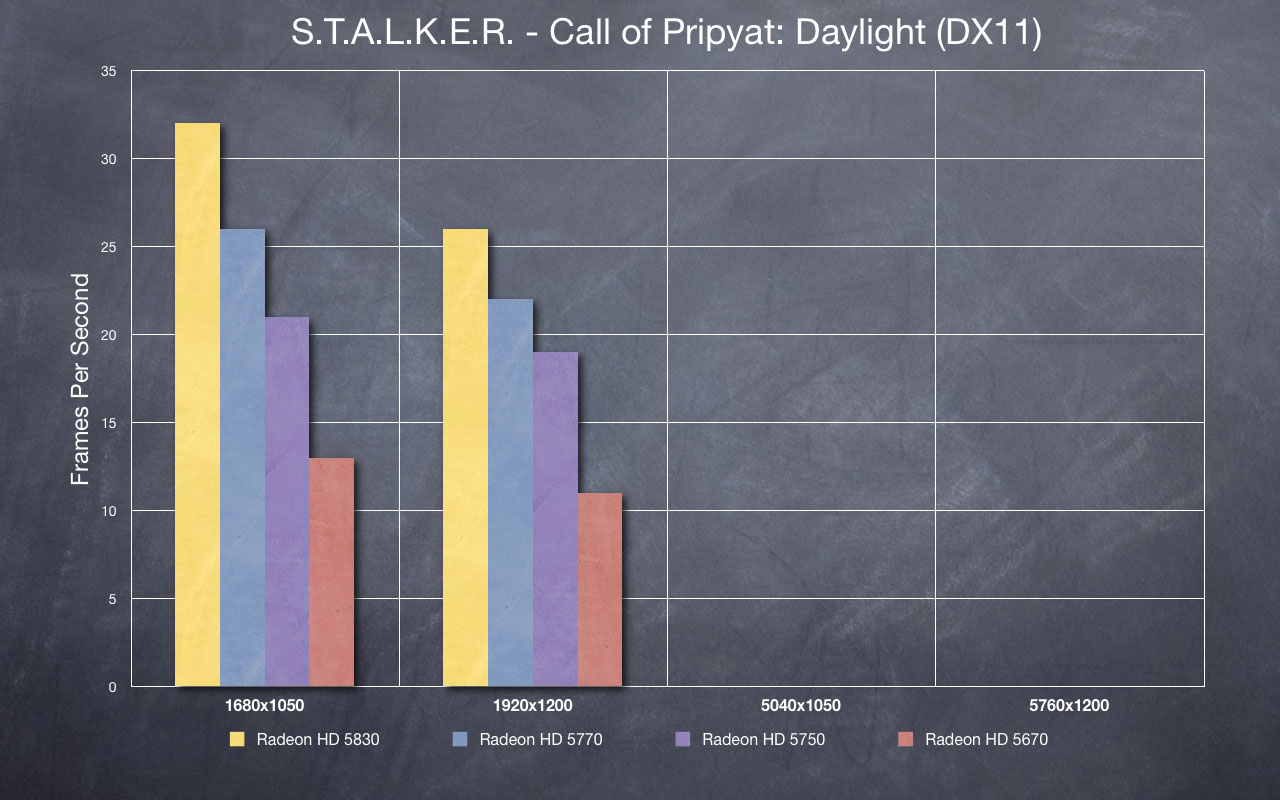
ATI Radeon 5770 & 5750 Review - S.T.A.L.K.E.R.: Call of Pripyat (Night)
S.T.A.L.K.E.R. - Call of Pripyat is the new Crysis.
Prior to the game's release, the developer put out a benchmarking tool to test your system configuration. It offers a number of different options for utilizing DX9, 10 or 11 code paths. It also offers options for varying levels of HDAO and Shadow Quality. The demo itself isn't very pretty to look at (lots of dirt and dirt-colors), but it does put a beating on your system.
Though the 5770 and 5750 perform admirably in widescreen resolutions, they cannot even run S.T.A.L.K.E.R. in Eyefinity. This should come as no surprise, as even the Eyefinity6 in CrossFireX never hit 30fps at 5760x1200. Like the Heaven demo, the CoP demo is intended to tax your system. Both of these are strong examples of how much more data is being pushed through an Eyefinity setup.
Hitting 60fps
Widescreen: I could crack 30fps by adjusting the benchmark settings. Forcing to DX10, 2xAA, HDAO Medium, and disabling every other option produced: Day - 36, Night - 32, Rain - 33, Sun Shafts - 24.
Eyefinity: I could crack 30fps with further quality reductions. Dropping to 4800x900, DX9 "Enhanced Full Dynamic Lighting " and 0xAA (almost every other option is disabled by avoiding the DX10 and DX11 code paths): Day - 35, Night - 35, Rain - 37, Sun Shafts - 20
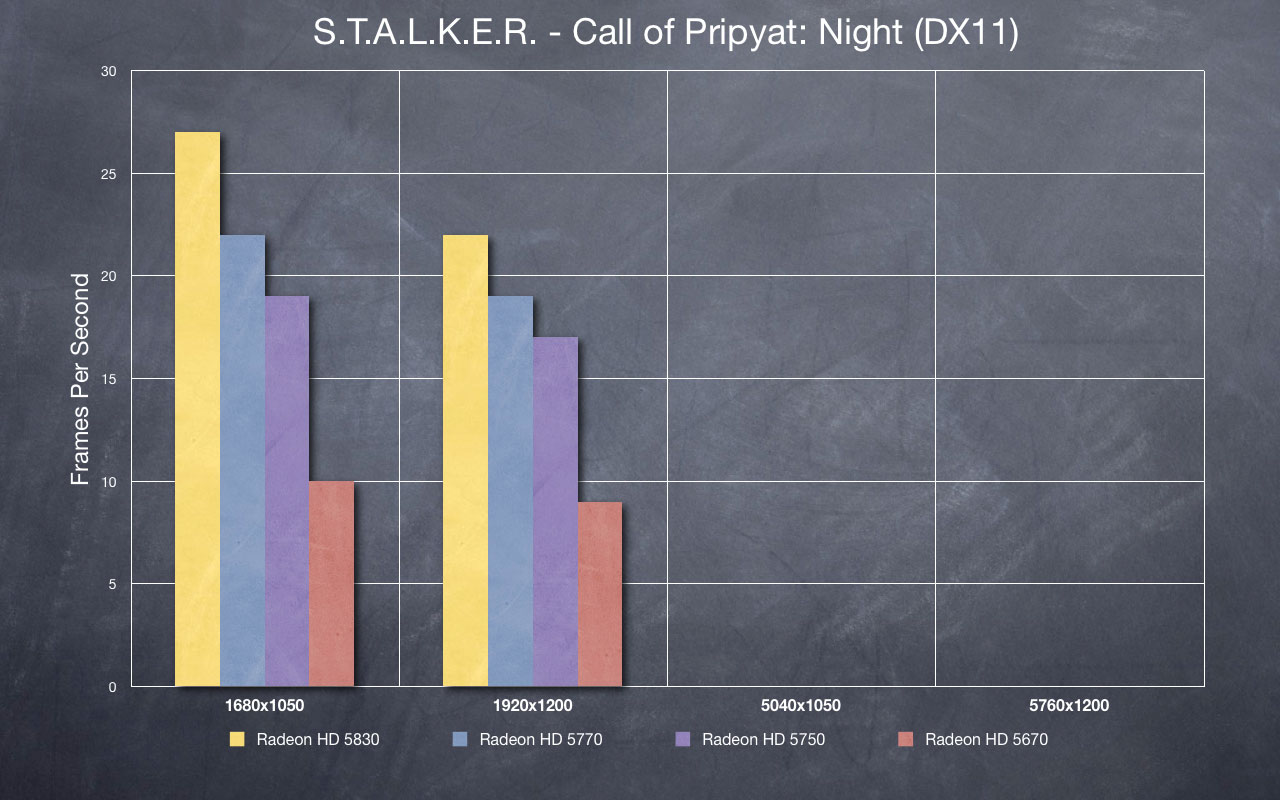
ATI Radeon 5770 & 5750 Review - S.T.A.L.K.E.R.: Call of Pripyat (Rain)
S.T.A.L.K.E.R. - Call of Pripyat is the new Crysis.
Prior to the game's release, the developer put out a benchmarking tool to test your system configuration. It offers a number of different options for utilizing DX9, 10 or 11 code paths. It also offers options for varying levels of HDAO and Shadow Quality. The demo itself isn't very pretty to look at (lots of dirt and dirt-colors), but it does put a beating on your system.
Though the 5770 and 5750 perform admirably in widescreen resolutions, they cannot even run S.T.A.L.K.E.R. in Eyefinity. This should come as no surprise, as even the Eyefinity6 in CrossFireX never hit 30fps at 5760x1200. Like the Heaven demo, the CoP demo is intended to tax your system. Both of these are strong examples of how much more data is being pushed through an Eyefinity setup.
Hitting 60fps
Widescreen: I could crack 30fps by adjusting the benchmark settings. Forcing to DX10, 2xAA, HDAO Medium, and disabling every other option produced: Day - 36, Night - 32, Rain - 33, Sun Shafts - 24.
Eyefinity: I could crack 30fps with further quality reductions. Dropping to 4800x900, DX9 "Enhanced Full Dynamic Lighting " and 0xAA (almost every other option is disabled by avoiding the DX10 and DX11 code paths): Day - 35, Night - 35, Rain - 37, Sun Shafts - 20
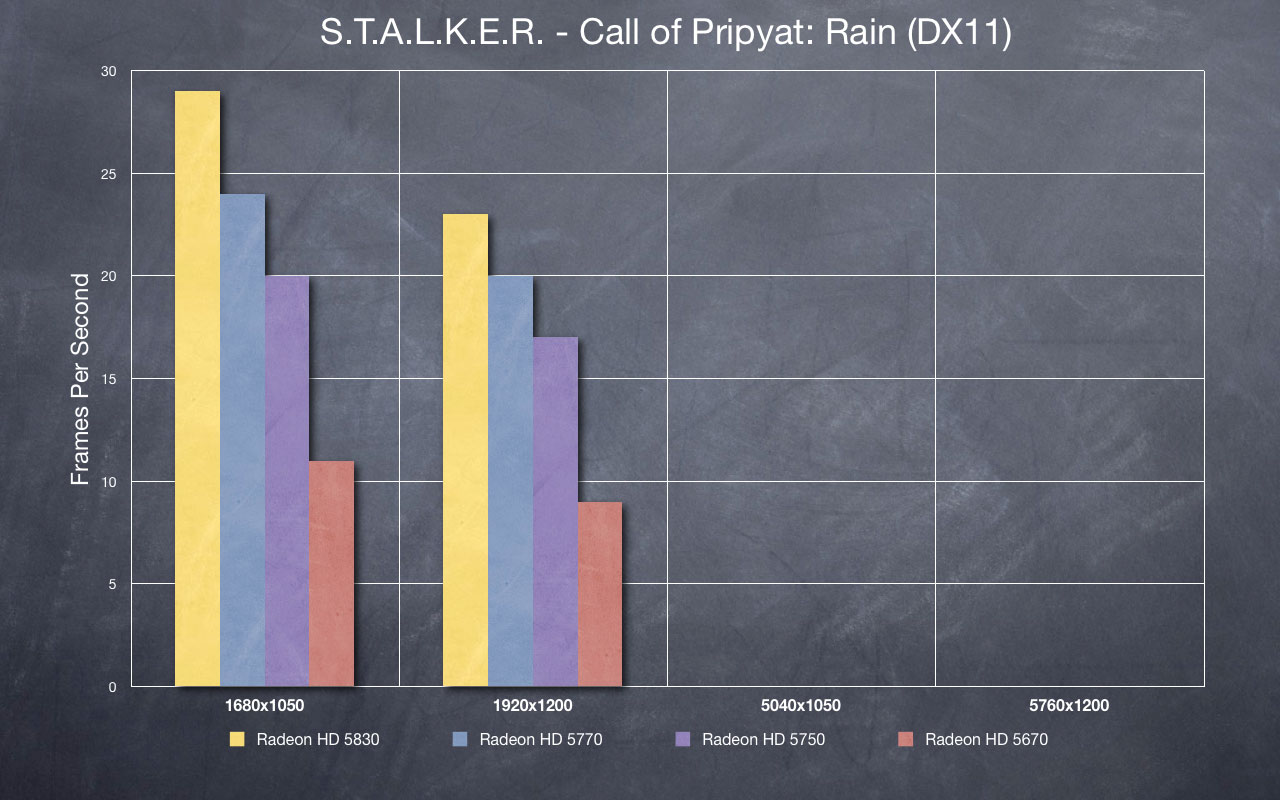
ATI Radeon 5770 & 5750 Review - S.T.A.L.K.E.R.: Call of Pripyat (Sun Shafts)
S.T.A.L.K.E.R. - Call of Pripyat is the new Crysis.
Prior to the game's release, the developer put out a benchmarking tool to test your system configuration. It offers a number of different options for utilizing DX9, 10 or 11 code paths. It also offers options for varying levels of HDAO and Shadow Quality. The demo itself isn't very pretty to look at (lots of dirt and dirt-colors), but it does put a beating on your system.
Though the 5770 and 5750 perform admirably in widescreen resolutions, they cannot even run S.T.A.L.K.E.R. in Eyefinity. This should come as no surprise, as even the Eyefinity6 in CrossFireX never hit 30fps at 5760x1200. Like the Heaven demo, the CoP demo is intended to tax your system. Both of these are strong examples of how much more data is being pushed through an Eyefinity setup.
Hitting 60fps
Widescreen: I could crack 30fps by adjusting the benchmark settings. Forcing to DX10, 2xAA, HDAO Medium, and disabling every other option produced: Day - 36, Night - 32, Rain - 33, Sun Shafts - 24.
Eyefinity: I could crack 30fps with further quality reductions. Dropping to 4800x900, DX9 "Enhanced Full Dynamic Lighting " and 0xAA (almost every other option is disabled by avoiding the DX10 and DX11 code paths): Day - 35, Night - 35, Rain - 37, Sun Shafts - 20
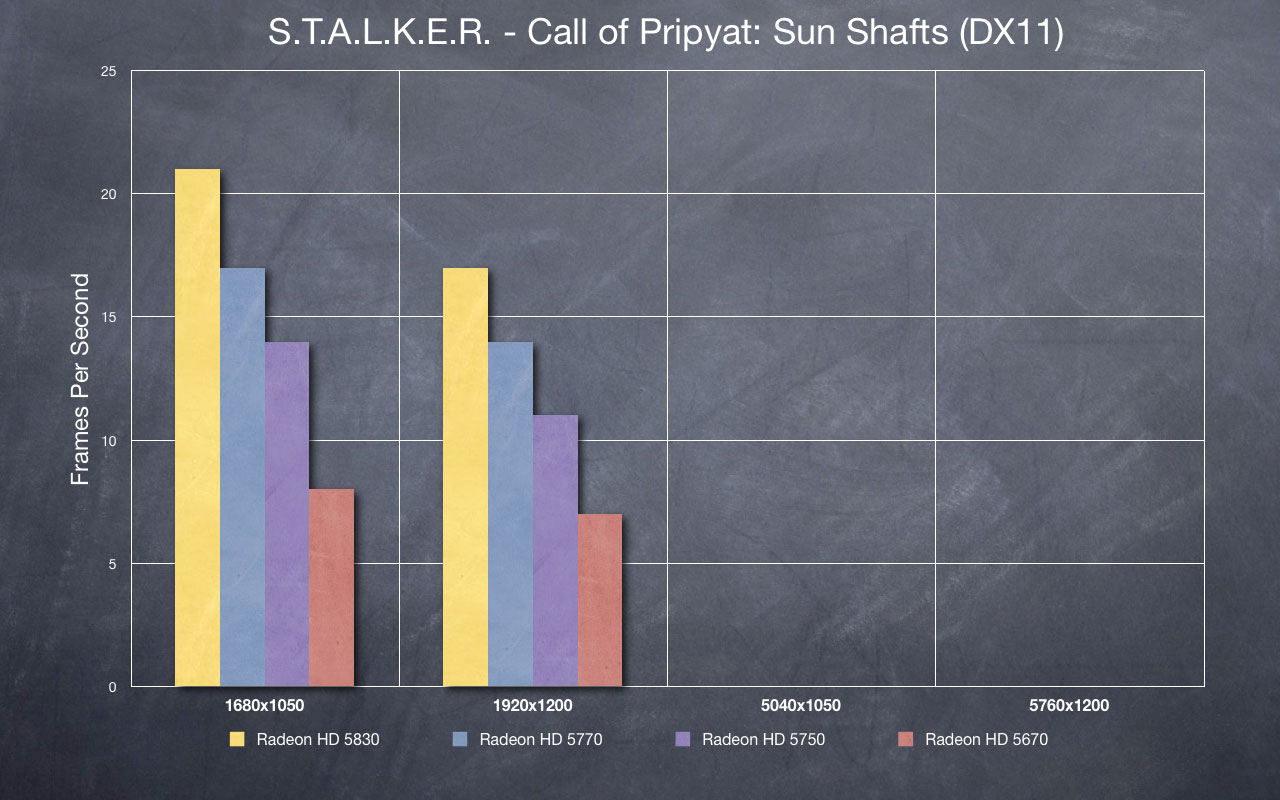
ATI Radeon 5770 & 5750 Review - Hitting 60fps in Eyefinity
While our testing is designed to stress the card as much as possible, we all realize that games have quality settings for a reason. So, beyond seeing where the breaking point is for any individual card, I wanted to provide some insight into what image quality you can expect and get 60fps at 5760x1080 (3x1920x1080) Eyefinity. These settings are for the HD 5770. Settings for the HD 5750 would need to be slightly lower.
Note, it is simply not possible to hit 60fps in many games at this resolution. In those instances we shot for 30fps.
Batman: Arkham Asylum - 0xAA/High gives you 49fps at 5760x1200. Dropping the resolution to 4800x900 yields bigger improvements. 0xAA/Very High gives you 54fps, while 0xAA/High gives you 69fps.
Battle Forge - 29fps by reducing the resolution to 4800x900 (3x1600x900) and using the above settings.
Dirt 2 - I was able to hit 54fps by dropping settings to 4800x900 at 0xAA. All other options were set to Medium, with the exception of: Post Processing, Ambient Occlusion, Particles, Crowd, Ground Cover and Cloth. All of those were set to Low.
Far Cry 2 - 60fps can be in with 0xAA, Very High Settings, and 4800x900.
GTA IV - Considering the problems I had trying to improve performance on my Eyefinity6 review, I didn't bother going through the effort here.
HAWX - Turning down the DX10 all to Low produced 46fps. Dropping the resolution to 4800x900 hit 61fps.
Heaven Demo - It is not possible to hit 60fps with this benchmark on a single GPU at Eyefinity resolutions. Considering it is meant to test/tax your system, that is to be expected. Dropping almost every setting down to minimums couldn't even hit 30fps in Eyefinity.
- DX9: 4800x900, 0xAA, 1xAF, low shaders - 22
- DX10: 4800x900, 0xAA, 1xAF, low shaders - 22
- DX11: 4800x900, 0xAA, 1xAF, tessellation enabled, low shaders - 17fps
Half-Life 2 - Both cards double the 60fps goal in widescreen.
STALKER - Hitting even 30fps isn't possible on the 5850 or 5830 with DX10 or DX11 effects. I was able to crack 30fps by dropping all the way back to DX9 code path and features. DX9 "Enhanced Full Dynamic Lighting", 4800x900, 0xAA. All other features are bypassed by avoiding the DX10 and DX11 code paths.
- Day - 35fps
- Night - 35fps
- Rain - 37fps
- Sun Shafts - 20fps
ATI Radeon 5770 & 5750 Review - Hitting 60fps in Widescreen
While our testing is designed to stress the card as much as possible, we all realize that games have quality settings for a reason. So, beyond seeing where the breaking point is for any individual card, I wanted to provide some insight into what image quality you can expect and get 60fps on a single widescreen. These settings are for the HD 5770. Settings for the HD 5750 would need to be slightly lower.
Note, it is simply not possible to hit 60fps in many games at this resolution. In those instances we shot for 30fps.
Batman: Arkham Asylum - 2xAA and Very High settings gives you 60fps at 1920x1080
Battle Forge - 50fps by reducing resolution to 1600x900, 0xAA, turned off DX11 and SSAO and set everything to Medium quality.
Dirt 2 - I was able to hit 57fps by moving all settings from Ultra to High, setting 2xAA and setting Post Processing to Medium. I hit 61fps by setting 0xAA.
Far Cry 2 - 60fps can be hit by dropping the settings to 0xAA and Very High.
GTA IV - Considering the problems I had trying to improve performance on my Eyefinity6 review, I didn't bother going through the effort here.
HAWX - I hit 65fps by turning the DX10 settings down one notch each. Shadows and Sun Shafts were set to Low, and SSAO to Medium.
Heaven Demo - It is not possible to hit 60fps with this benchmark on a single GPU at Eyefinity resolutions. Considering it is meant to test/tax your system, that is to be expected. Dropping almost every setting down to minimums couldn't even hit 30fps in Eyefinity.
- DX9: 1600x900, 0xAA, 1xAF, low shaders - 46
- DX10: 1600x900, 0xAA, 1xAF, low shaders - 44
- DX11: 1600x900, 0xAA, 1xAF, tessellation enabled, low shaders - 30fps
Half-Life 2 - Both cards double the 60fps goal in widescreen.
STALKER - I could crack 30fps with significant quality reductions. Forcing to DX10, 2xAA, HDAO Medium, and disabling every other option produced
- Day - 36fps
- Night - 32fps
- Rain - 33fps
- Sun Shafts - 24fps
ATI Radeon 5770 & 5750 Review - Conclusions
Conclusions
The 5770 is really the tipping point in the ATI Radeon HD 5000-series. It performs quite well in a single widescreen environment, and there are instances where it performs admirably in Eyefinity. If you frequently play older titles that aren't shader intensive, such as anything based on the Source engine (Half-Life 2, Team Fortress 2, Left4Dead), then the 5770 could well serve you in an Eyefinity environment. Even newer titles such as Batman and Dirt 2 can easily hit 30fps in Eyefinity.
All in all, the fact that you can get a playable Eyefinity environment for less than $200 is quite amazing. The 5770 is a card for the user who doesn't mind switching between single screen and Eyefinity based on performance. If you want a consistently playable (at or near 60fps) Eyefinity experience in every game, then you need to look at the 5800-series. However, if you're on the fence about multi-monitor, or you have a couple extra monitors you might hook up from time-to-time, the HD 5770 may very well be the card for you.
What's Next?
Since I've originally done this benchmarking (this review has been in the works for a while), I now have a the cards to test the 5850 and 5770 in CFX. I will be testing those in the near future to see if the 5770 provides a good stepping stone for a larger CFX build.
As I wrap up testing on the 5850 and 5770 in CFX, I will be producing charts that compare performance to total price. This will be the backbone of our forthcoming Eyefinity Buyers Guide.
Final Thoughts
Again, the 5770 performs very well in a single monitor environment, and quite well in Eyefinity. It does so with low noise and heat, and with low power requirements. We will shortly see if a 5770 CFX setup is worth the investment. Between the 5770 and 5750, I would recommend the HD 5770 for the extra $40. Based on the performance, it's quite amazing to see what a $175 card can now do. Considering the low power requirements, you shouldn't need to upgrade additional components in your system either.
The 5770 is an excellent mid-range card, and will allow the user to an excellent opportunity to try Eyefinity without extensive investment. I could easily see how this card could play out well in a college dorm environment - students are poor, and extra displays are as readily available as next door.